
As large airline companies compete to reduce emissions, fuel and noise, aircraft manufacturers are shifting more of their aircraft systems to electrical power. To help usher in the next revolution in aviation— hybrid electric and turboelectric aircraft – NASA is building and testing portions of a concept aircraft’s power systems with an eye toward the future.
NASA Glenn has repurposed its Hypersonic Tunnel Facility to create the NASA Electric Aircraft Testbed (NEAT). Located at Plum Brook Station in Sandusky, Ohio, NEAT is a world-class, reconfigurable facility that can accommodate power systems for large passenger airplanes like a Boeing 737, with megawatts of power. This testbed, which recently conducted its first megawatt-scale test, takes advantage of the facility’s massive amounts of available power to carry out research and technology development of aircraft electrical powertrains – like the power system seen here.
“We can layout an entire electric powertrain, not including the engines, in NEAT and test all of the key electrical systems for an electrified aircraft,” says Dr. Rodger Dyson, principal investigator.
NEAT also includes a vacuum chamber, where this photo perspective was taken from, which can currently simulate altitudes of up to 40,000 feet to test high-voltage power electronics, electric motors, and controls. Within the year, NASA plans to increase the altitude capability to over 50,000 feet.
“NEAT can make a difference in aviation because it has the power and size to investigate the full power capabilities of the next generation of hybrid and turboelectric aircraft,” says Dyson.
Image Credit: NASA/ Bridget Caswell, Alcyon Technical Services



























